Crowning Glory’ was written for Exmoor Magazine, by Michelle Werrett and accompanied with photographs by wildlife photographer Jochen Langbein; Issue 79, Summer 2017. Exmoor Magazine work with specialists in their respective fields to develop articles based on original research throughout the seasons. Michelle Werrett is a farm consultant specialising in the integration of wildlife conservation with commercial livestock production. She is currently working on a project to monitor the health and condition of deer on Exmoor, with support from the Badgworthy Trust. Photographer Jochen Langbein is a wildlife biologist who specialised in research into deer ecology and management for over 30 years.
Crowning Glory
by Michelle Werrett for Exmoor Magazine
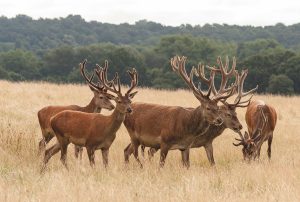
The summer afternoon is warm and peaceful and the combe snoozes contentedly. The deep bracken beds on the cleave are cool and damp below the shady fronds where the lightest breeze turns a leaf on the beech hedge. The combe appears uninhabited, utterly still and empty. But look closely…
That mossy twig amongst the bracken moved. It’s the tip of an antler! Once recognised, it’s easy to spot the opposite one. Then the flick of an ear, and there are two more pairs nearby; pale, soft antlers in velvet. Three stags are spending their afternoon reposing in the tall bracken, where only the flies disturb their peace. The kings are growing their crowns.
In summer, stags like to live alone or in the company of other stags. Whilst they are
re-growing, antlers are very tender so stags prefer to be quiet, away from the herd and they seem not to want females to witness the loss of dignity that accompanies the loss of their antlers.
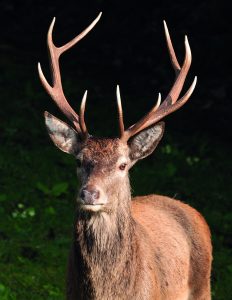
Antlers are unique, extraordinary structures. No other mammal body part can be lost and re-grown in the way that antlers are cast and restored annually, and no organ in the animal kingdom grows faster than antler. It can grow over two centimetres a day.
Antler growth is influenced by annual cycles of daylight length and hormone levels. Antlers grow as daylight grows. Many people on the moor will tell you that the stage of antler growth is the same as the stage of growth of the bracken fronds, and that is about right.
At around the time of the spring equinox the stags’ levels of testosterone are at their lowest and soon after that they cast their antlers. The oldest stags cast first. Really mature stags with heavy antlers may cast by the end of March, younger stags a week or two later and prickets not until the end of April. At this time of year it is interesting to watch the young stags ply their antlers to advantage in an attempt to dominate an older, bigger stag whom they would not have dared to defy before he cast. These attempts usually fail. When they have lost their antlers, stags are quite adept at boxing with their fore feet. A stag usually loses both his antlers within a short time, often no more than minutes or a few hours apart; but occasionally one may be lost and the other retained for several days. I imagine the feeling of lightness after suddenly losing a set of antlers must be quite a relief, but to lose just one must feel very unbalanced.
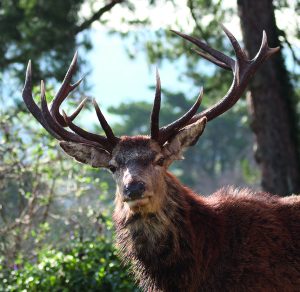
When do Deer Experience New Growth?
Growth of new antlers begins right after casting the old ones, but is relatively slow for the first month. After this, the growth rate accelerates rapidly and ninety-five per cent of the antler is formed between four and sixteen weeks. At this time the antlers are soft, with a profuse blood supply. I once came across a dead stag with antlers at this stage of growth that had sadly been knocked down by a car. I was shocked at how hot his antlers felt!
During growth, antlers are covered with a downy, short-haired skin known as ‘velvet’. Velvet is remarkable in its capacity to expand so that it keeps pace with the growing antler. The pale hair covering it is quite unlike the hair anywhere else on a deer’s coat – it is soft, short, erect and, well, velvety. From the time of the summer solstice, as daylight begins to decrease, testosterone levels begin to rise and antler to harden. At first, the bone of the antler shaft is of a spongy formation, riddled with a labyrinth of blood vessels. In late summer, as the days shorten, testosterone secretion accelerates, and blood supply to the maturing antler is restricted so that, from just below the tip, the density of the bone structure increases progressively down the beam. Eventually, blood supply to the antler ceases altogether. Extraordinarily, antlers are the only instance where living animal bodies retain dead bones!
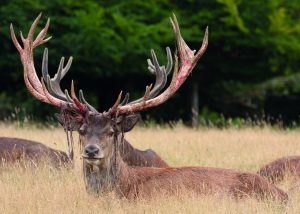
As the blood supply dwindles, the velvet dries up and begins to split and peel. It must feel irritating because the stags thrash about in bushes or on tree bark to get it off; a behaviour known, descriptively, as ‘fraying’. This activity can be rather enthusiastic and the damage they do to young trees in the process makes stags most unpopular with woodsmen. The velvet falls away in shreds to reveal the now dead, bony antler which, when newly exposed, is clean and white. As it ages, antler darkens and I’ve often imagined it like an apple browning when it is cut open to the air but I think, probably, the colouring is due mainly to dirt and tannins rubbed on from soil and bruised bushes.
Every year a stag’s antlers are a little different, but they always retain certain characteristics, similar to the way in which a man’s face changes with age, yet remains recognisable. As a stag matures, his antlers develop more points, but the curve of the beam, the general shape and set of the head remain constant. When a stag passes his prime, in old age, his antlers deteriorate, becoming misshapen, often with blunted tips, and the number of points reduces again.

When do Deer get Antlers?
In his first year of life, as a calf, a male deer has no antlers. As a yearling, he will grow his first set which are simple, upright spikes and he is called a pricket. When he is two, his antlers will branch and, from low down on the beam, a horizontal tine will curve forwards, which is known, reasonably enough, as a brow point. If he has no other points he would be described as a ‘brow, upright’ but he will soon develop another branch, a trey point, higher up on the beam, and become a ‘brow, trey, upright’. From then on, he will grow larger, heavier antlers with more points each year. As a mature stag, he gains his bay point, which emerges just above the brow point and is often shorter. With brow, bay and trey he is considered to be in his prime and if he has this set of points on both sides he is referred to respectfully as having ‘all his rights’. He might have, for example, brow, bay and trey with the upright beam branching into three at the tip and he would then be described as a ‘rights and three’. Exmoor tradition has it that, if a little point is sufficient to hang a wedding ring on, it counts!
Antler size, and the number of points a stag carries, do give some indication of age but this is not infallible because antler formation is also influenced by nutrition. Stags on Exmoor Forest generally have lighter-weight antlers, slimmer in the beam, than those from south of the moor where a milder climate and more fertile farmland produce better-quality feed. The same influence has also produced variation over time, and heads of stags today are much heavier than heads carrying the same number of points from stags killed perhaps 50 to 70 years ago or more. This development is illustrated by sets of antlers that may be seen on the walls of farmhouse kitchens all over the moor and the Quantock Hills.
During and after the Second World War, agriculture on Exmoor improved significantly. Wet land was drained, rough grazing was cultivated and the judicious use of lime and fertiliser enabled superior quality pasture to be produced and crops of roots and cereals to be grown. The deer benefitted enormously because, as the farming improved, they could obtain much better nutrition.
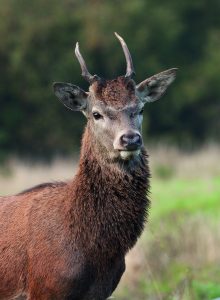
The time of year a male calf is born also has a bearing on the head he will produce when he grows up to be a stag. Calves born earlier in the year benefit from better early nutrition, get a good start in life and put on more growth during their first summer and these animals will go on to produce finer antlers throughout their lives than those born later in the year.
When autumn comes, the three stags lying peacefully together in the combe will go their separate ways and each will attempt to join a group of hinds and followers of which he can be lord. Each stag will strut around his courtiers showing off the splendour of his antlers, which are both adornment and weaponry. The size and complexity of a stag’s antlers are directly related to his testes size and sperm velocity, so antlers are conspicuous advertisements of a stag’s reproductive capacity. They are also a display of arms, warning rival stags of their carriers’ fighting ability. As the rut progresses, antlers will be used to prod straying hinds back to the herd, to gouge the earth in fits of frustrated passion and, if rivals are bold enough to challenge authority, they will be used to fight.
Rutting
When two rival stags meet during the rut, the question of dominance must be settled. If they are of unequal size this is usually done peacefully and the smaller animal will leave. However, two stags of similar size are likely to resort to violence and the combe will ring with their clashing weapons. Antlers can cause serious, sometimes fatal, injuries.
As stags thread their dappled paths through the woods, dip through the goyle and pace over the moor they carry their noble heads with the pride of monarchs. Antlers are their badges of kingship; their glorious crowns of majesty.
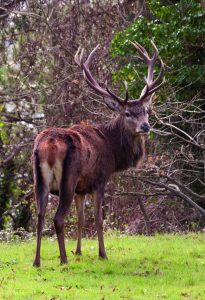
Photograph captions
Crowning Glory 01 and Crowning Glory 02.
A stag in velvet in mid-June and, six months later, after shedding his velvet. He was known to be at least 12 years old when these photographs were taken (photos by Jochen Langbein).
Crowning Glory 03.
Stags in velvet at the height of summer (photo by Jochen Langbein)..
Crowning Glory 04.
A stag with cleaned antlers on the left and one still in velvet on the right – the pair of them hidden in the bracken… as they often are in summer (photo by Jochen Langbein).
Crowning Glory 05.
As a yearling, this deer has grown his first set which are simple, upright spikes; he is known as a pricket (photo by Jochen Langbein).
Crowning Glory 06.
A stag shedding his velvet at the end of summer (with a stag still in velvet behind) (photo by Jochen Langbein).
Crowning Glory 07, 08 and 09.
The last three images are of the same stag in three consecutive years, showing the development of his antlers over time (photos by Jochen Langbein).
2014 – brow, trey, two; rights and two.
2015 – rights and three.
2016 – rights, six and three.

Article is copyright of Exmoor Magazine.
Find out more about receiving the magazine direct through your letterbox each season at:
facebook.com/exmoormagazine
Instagram @exmoormagazine
On the Best of Exmoor blog we have an article about the Red Deer Safari
All of our cottages are located near herds of deer (and Exmoor Ponies)




